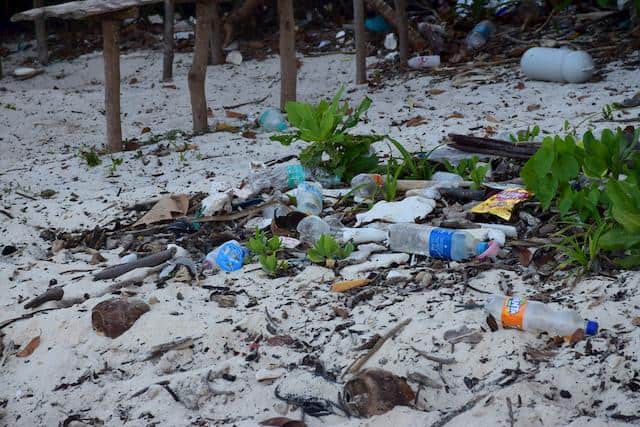By: Nimra Sardar
One of the most important and concerning problems in developing nations is plastic pollution, which has a significant negative influence on both the environment and human health. Plastic pollution is the buildup of plastic objects and particles in the environment that harms people, wildlife, and their habitat. Examples include plastic bottles, bags, and micro beads. As the world’s capacity to deal with the fast rising output of disposable plastic goods becomes overwhelmed, plastic pollution has emerged as one of the most urgent environmental challenges. Not just in the oceans, but everywhere there is plastic waste. In today’s world, the typical human consumes and breaths in hundreds of microplastic daily. Plastic emits poisons into the environment both during the manufacturing process and when the chemicals needed to create it leak out. Nearly everyone on Earth, including unborn children, now has these toxins in their blood.
A significant contributor to the environmental contamination caused by plastic is microplastic. Microplastics are very small pieces of plastic that are produced during the breakdown of bigger plastics and during the production of commercial products. Microplastics are pollutants that have the potential to impair both the environment and animal health. Numerous terrestrial and aquatic species are affected by microplastics because they enter the food chain. Because they are so small in size, microplastics are frequently eaten by marine species. Additionally, the harmful compounds found in plastic can harm fertility and raise the risk of disease. Microplastics cannot be gathered nor even seen with the naked eye due to their microscopic size. It can take hundreds or even thousands of years for plastic to break down. Although littering contributes to some of this environmental contamination, plastic is also spread by storms, water runoff, and winds. The most prevalent kind of environmental plastic waste is little plastic fibres found in the filters of cigarette butts. The next most popular things are stirrers, plastic bottles, plastic bottle caps, plastic supermarket bags, and plastic food wrappers.
Plastic contamination causes a variety of issues. Both the environment and living things are negatively impacted by plastic. Humans consume fish tainted with plastic. In 114 marine species, researchers have discovered microplastics. Smallest organisms like plankton are impacted by these microplastics. Plastics kill millions of creatures per year, including fish, birds, and other marine life. It is known that plastics have had an impact on nearly 700 species, including endangered ones. Plastic is consumed by almost all species of seabird. Plants are also at risk from microplastics. In landfills, plastic waste mixes with water to create dangerous compounds. Plastics come in a wide variety and are found in landfills. Due to the discharge of toxic chemicals, burning plastic outdoors causes environmental damage. When humans and animals breathe in filthy air, it can have an adverse effect on their health and lead to respiratory issues.
A global epidemic exists with plastic garbage, and it’s becoming worse every day. By 2040, it’s anticipated that ocean plastic pollution will have tripled. Additionally, it is anticipated that Pakistan alone generated 3.9 million tonnes of plastic garbage in 2020. About 70% of this plastic garbage (2.6 million tonnes) is improperly managed, dumped in landfills or other uncontrolled locations, or it is scattered across the nation’s land and waterways. The enormous strain on the globe is growing by the day. There are numerous initiatives aimed at reducing plastic waste, as well as numerous techniques for recycling plastic. In order to combat plastic pollution, Pakistan implemented oxy-biodegradable technology in 2017. After their useful life, oxy-biodegradable polymers totally biodegrade in the environment without having any negative effects on the environment. The greatest plastic garbage collecting operations in Pakistan were started by PepsiCo in 2021, and more than 16,000 tonnes of plastic were collected and repurposed. The Ministry of Climate Change and WWF-Pakistan have both expressed their appreciation for this initiative, which is the largest voluntary plastic collection programme in Pakistan.
Despite current efforts, 75 to 199 million tonnes of plastic are still thought to be present in our oceans. The quantity of plastic garbage entering aquatic environments might nearly triple from 9 to 14 million tonnes per year in 2016 to an estimated 23 to 37 million tonnes per year by 2040 if we don’t modify how we make, consume, and discard plastic. According to estimates, 1,000 rivers are responsible for between 0.8 and 2.7 million tonnes of the world’s yearly riverine plastic emissions into the ocean, with small urban rivers among the worst offenders.
We have to reduce the use of plastic in over daily life so that we prevent over environment from hazardous effects of plastics. We should promote biodegradable bags or cloth bags and avoid polyethylene bags. Avoid the use of plastic water bottles and straws. Avoid synthetic wearing. Stop using single use plastic.
There is a need for better education and awareness around plastic waste and to make more policies on recycle plastic and limit waste production.

